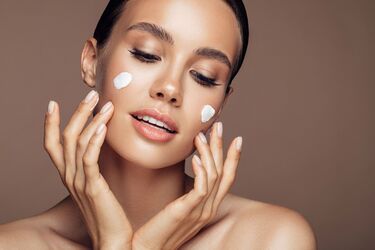Top misconceptions about cosmetics that even doctors make

The information age in which we live does not exclude myths and prejudices in the minds of many. In my practice, I regularly come across misconceptions about skin care not only among patients but also among my fellow doctors. Here are some of the most common ones.
Here is the text in the original language
Misconception 1: The skin becomes lazy and stops producing collagen and other nutrients when it receives them with creams
A similar misconception exists around the intake of enzymes, that if you often receive them from the outside, the body stops producing them. In the case of the pancreas, this organ independently determines the amount of enzymes needed at the moment (if there are a lot of them, it suspends production for a while, if there are few, it makes up for lost time). It's a similar story with the skin, which adapts to skincare products no more than the body gets used to a healthy diet. The thing is, the collagen and elastin we get with creams are not identical to those produced in the dermis. In most cases, the molecule of artificial collagen is too large to penetrate the skin and bind to the natural substance. Yes, collagen from creams can be a good moisturizing ingredient, but it does not inhibit its natural production.
Misconception 2: Before going to bed, you need to moisturize your face with a cream labeled "night"
The only difference between day and night moisturizers is that the daytime version should provide SPF 30 or higher sun protection. The claims of cosmetics manufacturers that the skin needs different ingredients at night than during the day, since it is at night that it performs the bulk of the repair work, have no evidence base. I have never seen a scientifically based list of substances that the skin needs at night. Repair and regeneration processes occur every nanosecond, regardless of the time of day.
Misconception 3: A red nose means that he drinks
In fact, whether a person's nose is red or not cannot be used to judge their lifestyle. Redness and inflammation in the upper third of the face and nose are characteristic symptoms of rosacea, a facial skin disease that now affects one in ten people, according to some reports. Recently, a major French cosmetics company conducted a study among patients with this disease. Many people with rosacea complained about the pressure from society, the need to prove to others that we do not drink and do not lead an unhealthy lifestyle. Yes, alcohol is one of the risk factors for rosacea, but not the direct cause. So, judge not and be not judged.
Misconception 4: Natural ingredients in cosmetics are better for the skin than synthetic ones
The fact that an ingredient is found in nature does not automatically make it good for the skin. And given that the definition of "natural and natural" is not legally fixed and is very vague, any cosmetics company can use it to increase the attractiveness of its products. The opposite is also true: the synthetic origin of an ingredient does not mean it is "harmful". Quite the contrary. For example, anti-aging cosmetics with hormonal ingredients should not be used for oncorrhosis, while innovative products with synthetic estrogen ester can be used.
Misconception 5: In winter, lips need to be constantly moisturized with balm, otherwise they will crack and develop crusts.
I don't argue that moisturizing your lips before going out is useful and correct, but if you repeat this manipulation more than 4-5 times a day and feel a constant urge to put on lipstick, it is possible that you are addicted to lip balm. The fact is that many popular lip balms contain fatty substances: mineral oils and waxes that create a very dense film on the surface of the lips. This film, when applied frequently, reduces the production of your own lipids, and there are already few of them in the skin of the lips. When the lip balm is worn off, you feel dry, because your own protection is no longer sufficient. Today, manufacturers have begun to fight this effect and include vitamin E, almond oil, apricot kernel oil, and new peptides in their balms to restore the skin's protective properties. Sometimes dry lips appear due to the daily use of anti-aging creams with retinol. This is one of the side effects of this substance. The sensation of dryness and irritation prompts you to constantly apply some kind of nourishing product to them. People who have undergone lip augmentation or lip reshaping often experience similar discomfort. If your hands are constantly reaching into your purse for a balm, I recommend switching to softer products. And, of course, don't forget to apply day and night creams to your lips in the morning and before bed.
Misconception 6: Retinoids will save youth and beauty
I often hear my patients say that retinoids are the best and most effective cosmetic substances. I agree, they work: creams with them prevent the development of comedones, reduce sebum synthesis, quench inflammation, and are used to treat acne and as anti-age products, as they activate collagen synthesis and regeneration processes in the skin. But there is a caveat - the safety of retinoids has not been established. They cannot, for example, be used during pregnancy. In summer, these substances can provoke the appearance of age spots, so it is better to use them in winter and autumn. Retinoids in creams can be identified by their second names on the package: isotretinoin, isotrexin, vitamin A.
Misconception 7: Expensive cosmetics are better than inexpensive ones
The truth is that there are good and bad products in all price categories. It's all about the composition, not the price. An expensive soap may be no better for the skin than a budget soap, and a non-irritating toner from a mass manufacturer may be no worse than a toner of the same effect from a luxury brand. Moreover, any toner that soothes the skin is much better than a product containing alcohol, menthol, essential oils, eucalyptus, lemon, or other irritants, regardless of how natural its ingredients are or how high its price is. Sometimes, expensive products are nothing more than water and wax, while inexpensive ones have a good, effective composition.

